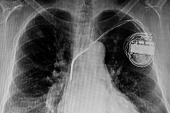Low Use of Lead Extraction for Device-Related Endocarditis Spurs ‘Call to Arms’
This shows that people are not practicing guideline-directed care, one expert says, adding that he’s “not surprised but very scared.”

Less than one out of every eight patients with infective endocarditis and a cardiac implantable electronic device (CIED) underwent recommended transvenous lead removal/extraction over a recent 4-year period, a rate described as “alarmingly low” and “scary” by experts.
That the vast majority of patients aren’t having their devices and leads removed in this scenario is particularly concerning because extraction—which was performed with a low rate of complications—was associated with reduced rates of in-hospital morality during the initial admission (6.0% vs 9.5%) and during the first 30 days (6.8% vs 10.6%; P < 0.001 for both), according to a study published online ahead of the May 2, 2023, issue of the Journal of the American College of Cardiology.
There are growing numbers of patients with CIEDs and thus increasing opportunities for device-associated complications, including infections, that can increase morbidity, mortality, and costs. In the presence of certain types of infections, like endocarditis, it’s recommended that device systems and leads are completely removed, but many physicians may not be aware of this guidance or may be hesitant to refer patients for extraction due to fears of procedure-related complications. Moreover, use of extraction may be limited by lack of access to specialists or necessary equipment.
Senior author Jim Cheung, MD (Weill Cornell Medicine, New York, NY), told TCTMD that when his team wrote the paper, they hoped it would inspire a call to action to increase use of lead extraction.
“We think that we can certainly do better. We owe it to our patients,” Cheung said, noting that multiple groups are working on educating not only medical teams, but also patients, on the strong recommendations for lead extraction in the presence of endocarditis. “These devices are lifesaving therapies, but as with any other form of therapy there’s always a small risk of complications which we must manage. What makes this a little bit different is the fact that these kinds of complications can occur years down the road as opposed to very soon after the procedure.”
We can certainly do better. We owe it to our patients. Jim Cheung
Commenting for TCTMD, Laurence Epstein, MD (Northwell Health, Manhasset, NY), said he was “not surprised but very scared” about the low rate of extraction observed in this study, which confirms prior research and clinical experience. The biggest reasons patients don’t undergo extraction, he said, are a fear of complications and lack of available programs.
Those barriers need to be overcome, Epstein said, noting that a prior study showed that even among patients who underwent lead extraction in response to a systemic infection, 1-year mortality was about 25%. Delayed referral for extraction, he added, contributes to that high risk.
“What we’ve been trying to do is have people understand that a systemic device-related infection is a life-threatening illness,” Epstein said. “This paper is important because it again points out that people are not practicing guideline-directed medical care.”
National Readmissions Database
For the study, with lead author Christopher Sciria, MD (Weill Cornell Medicine, New York, NY, and University of Rochester Medical Center, NY), the investigators turned to Nationwide Readmissions Database, examining data on 25,303 admissions at US centers involving patients with CIEDs and endocarditis between January 2016 and November 2019. Of the patients (mean age 71.2 years; 39.5% women), most (65%) had a pacemaker and 35% had an implantable cardioverter-defibrillator (ICD).
Overall, 11.5% of patients were managed with lead extraction, a proportion that increased from 7.6% to 14.9% during the study period. The complication rate associated with extraction was low (2.7%)—complications included pneumothorax/hemothorax (1.8%), cardiac perforation/tamponade (0.5%), and superior vena cava injury/innominate vein injury/other vascular complications (0.4%).
Mortality during the initial admission and during the first 30 days was lower among patients managed with versus without extraction, although there was no difference 30-day readmission rate.
After adjustment for clinical and hospital characteristics, extraction was associated with lower odds of index mortality, with adjusted odds ratios of 0.47 (95% CI 0.37-0.60) using multivariable logistic regression and of 0.51 (95% CI 0.40-0.66) using propensity-score matching. The findings were similar for 30-day mortality.
Boosting Extraction Rates
Asked where the fear of extraction-related complications originated despite low observed rates, Cheung noted that when they do occur, complications can be catastrophic. A superior vena cava tear can be associated with significant mortality, for instance.
This study, which used nationally representative data and did not focus only on experienced centers, should ease some of those concerns by underscoring that such complications are infrequent, Cheung said.
But knowledge gaps also contribute to the low rate of extraction, Cheung said. “I think that there’s simply a lot of physicians who don’t know that if you have endocarditis and an indwelling device, even if the patient is stabilized and has cleared their blood cultures, device system removal is required for long-term clearance of the infection.” Efforts should be made to inform all physicians, and not just cardiologists, of this, he added.
In addition, patients need to be informed about the issue and should be able to recognize the signs of an infection that potentially involves their implanted device.
“What patients need to be aware of is that even several years down the road, even if the device implant procedure by that point is no longer the cause of the infection, infections elsewhere can then result in seeding of the device, which then means that the device becomes included in that systemic infection,” Cheung said. “And that is something that we need to do a better job of explaining to our patients.”
It’s really upsetting to see that here we have a condition that has a 1-year mortality that’s worse than most cancers these days and yet people are not treating it appropriately. Laurence Epstein
Epstein highlighted the same barriers, estimating that fewer than 5% of patients with a CIED and infective endocarditis have an absolute contraindication to lead extraction. He said he’s involved with an American Heart Association effort to raise awareness about device-related infection and how it should be managed.
At some centers, he said, screening tools are being integrated into electronic health record systems to identify patients who potentially require device removal and lead extraction in response to an infection.
“It’s got to be a multipronged approach to doing this,” Epstein said. “It’s really upsetting to see that here we have a condition that has a 1-year mortality that’s worse than most cancers these days and yet people are not treating it appropriately. So really the goal is to increase awareness both of the importance of getting these leads and devices out as soon as possible—because there’s growing data that suggest by waiting you dramatically increase mortality—and that extraction done well is not a high-risk procedure in the sense that the overall complication rate and mortality is quite low and certainly much lower than that related to an untreated infection.”
For Ayman Hussein, MD (Cleveland Clinic, OH), and colleagues, who wrote an accompanying editorial, the “alarmingly low” rate of extraction cited in the study, should be the “call to arms” that Cheung was hoping for.
“It is imperative for all healthcare providers managing patients with CIEDs to recognize CIED-related infections and make early referrals for extraction,” they write. “Unless there are clear prohibitive factors such as terminal illness or patients’ preferences of goals of care, no other strategies should be acceptable for the management of patients with CIEDs and infective endocarditis.”
Todd Neale is the Associate News Editor for TCTMD and a Senior Medical Journalist. He got his start in journalism at …
Read Full BioSources
Sciria CT, Kogan EV, Mandler AG, et al. Low utilization of lead extraction among patients with infective endocarditis and implanted cardiac electronic devices. J Am Coll Cardiol. 2023;81(17):1714-1725.
Hussein AA, Wazni OM, Wilkoff BL. Cardiac implantable electronic devices and infective endocarditis: a call to arms. J Am Coll Cardiol. 2023;81(17):1726-1728.
Disclosures
- The study was supported by grants from the Michael Wolk Heart Foundation, the New York Cardiac Center, and the New York Weill Cornell Medical Center Alumni Council.
- Cheung reports having received consulting fees from Abbott, Biotronik, and Boston Scientific; research grant support from Boston Scientific; and fellowship grant support from Abbott, Biosense Webster, Biotronik, Boston Scientific, and Medtronic.
- Hussein and Sciria report no relevant conflicts of interest.





Comments